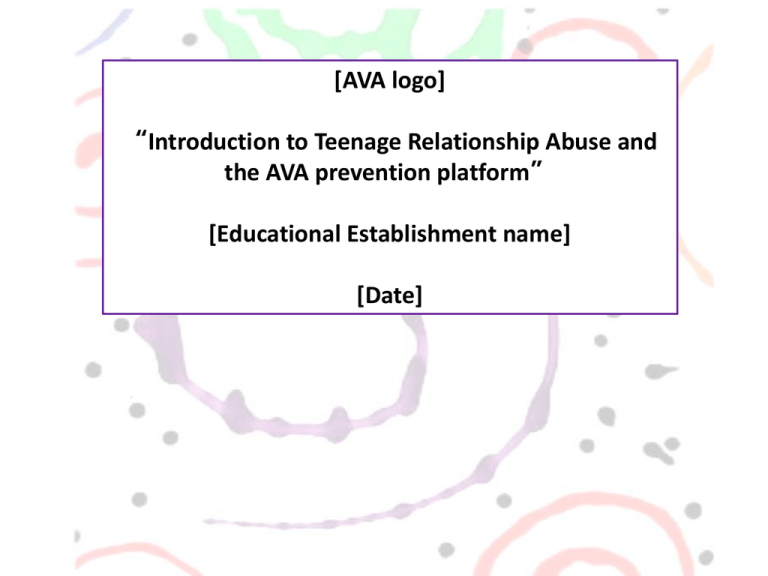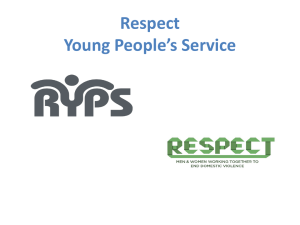
[AVA logo]
“Introduction to Teenage Relationship Abuse and
the AVA prevention platform”
[Educational Establishment name]
[Date]
Today’s session:
Setting the scene: looking at VAWG and related sexual and domestic
violence in the UK
Understand what current research says about young people’s
experiences of domestic/sexual violence and relationship abuse
Understanding teenage relationship abuse
Introduction to AVA's (Against Violence and Abuse) ‘Prevention
Platform’ online toolkit to plan our school/ educational
establishment's intervention
Look at what resources are available locally and nationally to
support young people/families who are experiencing domestic/
sexual violence
Intro to AVA:
Who are AVA?
AVA is a national second tier service working to end all forms of
violence against women and girls. The key aims of AVA are:
1. To challenge, enable, encourage and support all agencies and
communities to contribute to achieving our vision of a world free
from violence against women and girls.
2. To offer a range of high quality and expert services to facilitate
specialist and generic agencies to contribute towards our vision.
3. To identify and fill gaps in the field, find innovative solutions to
current and emerging situations and inspire an effective strategic
approach to reducing and preventing violence against women
and girls.
The prevention platform:
‘Prevention Portal’ – funded by Comic Relief, creating an
online toolkit that enables a ‘whole school approach’ in
preventative work.
Created to support education practitioners across the UK to
develop and deliver a comprehensive programme to stop
violence against women and girls. It is based on the specialist
knowledge and experiences of teachers, youth workers,
service providers and local authority leads from across the
country.
The toolkit encompasses e-training, lesson plans and sources
of support for working with students around these issues
Safety in the session…
As time is limited, we offer these ‘ground rules’ for safety in the session:
Confidentiality – what does this mean in our learning environment?
Respectful listening and hearing. Challenging the ideas or behaviour, not the
person
'Own' your contributions without generalising
Be conscious of body language and nonverbal responses - they can be as
disrespectful as words
Self-care: looking after ourselves as practitioners when dealing with
particularly sensitive issues
Appropriate humour welcomed!!
Icebreaker:
Where did you learn about sex
and relationships as a young
person?
Definition…
“Any incident or pattern of incidents of controlling, coercive or threatening
behaviour, violence or abuse between those aged 16 or over who are or have been
intimate partners or family members regardless of gender or sexuality. This can
encompass, but is not limited to, the following types of abuse: psychological,
physical, sexual, financial, and emotional’
(Home Office, 2013)
Originally referred to over 18’s only – this changed in March 2013 to include 16 and
17 year olds.
Explicitly includes ‘coercive control’
The inclusion of 16 and 17 year-olds is a much needed development given that 40%
of teenagers report abusive intimate relationships and that, according to the Crime
Survey for England and Wales, those aged between 16 and 24 are the most at risk of
domestic violence of any age group.
(CSEW, 2010/11)
Setting the scene:
[Trainer's 'to do' action: Insert local statistics alongside these national figures
– these should be easily obtained from local community safety and
sexual/domestic violence websites/services]
In 2011/12, 7.3% women (1.2 million) and 5% men (800,000)
report having experienced domestic abuse (ONS, 2013)
2 women die every week in the UK due to DVA
35 incidents of domestic violence before reporting
?? reports of domestic violence to the police in [insert area]
per year
Young People’s experiences…
Up to three million women across the UK experience rape,
domestic violence, forced marriage, stalking, sexual exploitation
and trafficking, female genital mutilation (FGM) or so called honour
violence each year.
Almost one in three girls have experienced unwanted sexual
touching at school.
Associated factors, both for experiencing and instigating teenage
partner violence, included: previous experiences of child
maltreatment, domestic violence in the family and aggressive peer
networks. For girls, having an older partner, and especially a “much
older” partner, was associated with the highest levels of
victimisation.
(From ‘A different world is possible’ (2011) , End Violence Against Women Coalition)
Young People’s experiences…
71% of 16-18-year-olds say they have heard sexual name-calling such as “slut” or
“slag” towards girls at school daily or a few times per week
Close to one in three (29%) 16-18-year-old girls say they have experienced
unwanted sexual touching at school
One in three (28%) of 16-18-year-olds say they have seen sexual pictures on
mobile phones at school a few times a month or more
Close to one in four (24%) 16-18-year-olds said that their teachers never said
unwanted sexual touching, sharing of sexual pictures or sexual name calling are
unacceptable
40% of 16-18-year-olds said they didn't receive lessons or information on sexual
consent, or didn’t know whether they did
(YouGov, 2010)
Local young people’s experiences…
[Trainer's 'to do' action: Again, use local data from Police, Local Authorities,
sexual and domestic violence services and educational establishment
information and experiences to 'set the scene' in terms of teenage
relationships abuse locally ]
An activity:
What do we understand about
teenage relationship abuse?
Support for young people:
Locally:
[Trainer's 'to do' action: Populate this page with details of local support
services for children and young people. This can include information, advice
and guidance services, youth projects, local sexual and domestic abuse
support services as well as 'in-house' support offered by your educational
establishment ]
Support for young people:
1. This is Abuse’ website: http://thisisabuse.direct.gov.uk/
2. National LGBT DV helpline http://www.brokenrainbow.org.uk/
3. The Child Exploitation and Online Protection (CEOP) Centre
www.ceop.gov.uk/
4. Women’s Aid website for CYP http://www.thehideout.org.uk
5. ‘Respect’ (work with perpetrators', male and female)
http://www.respect.uk.net/
6. Safe and Sound http://www.dudleysafeandsound.org
7. National Stalking Helpline http://www.stalkinghelpline.org/
8. ChildLine: 0800 1111 or http://www.childline.org.uk
What next...?
Contact
SRC
Commitment to undertaking e-learning on prevention platform
website
A
Use the online AVA toolkit to create a school plan to address VAWG
in our educational establishment
Commit time for regular updates on latest guidance and resources
that highlight these issues
Attending/ requesting training (see training needs assessment)
Research local sources of support to inform our work with CYP
Identify an in-house champion/ working party to carry this work
forward.









